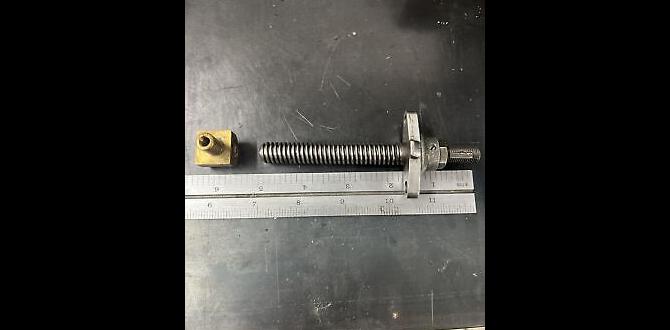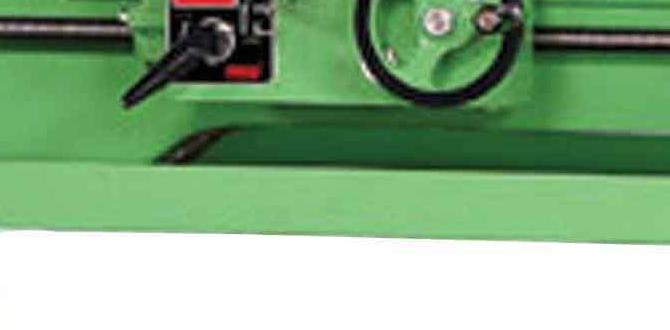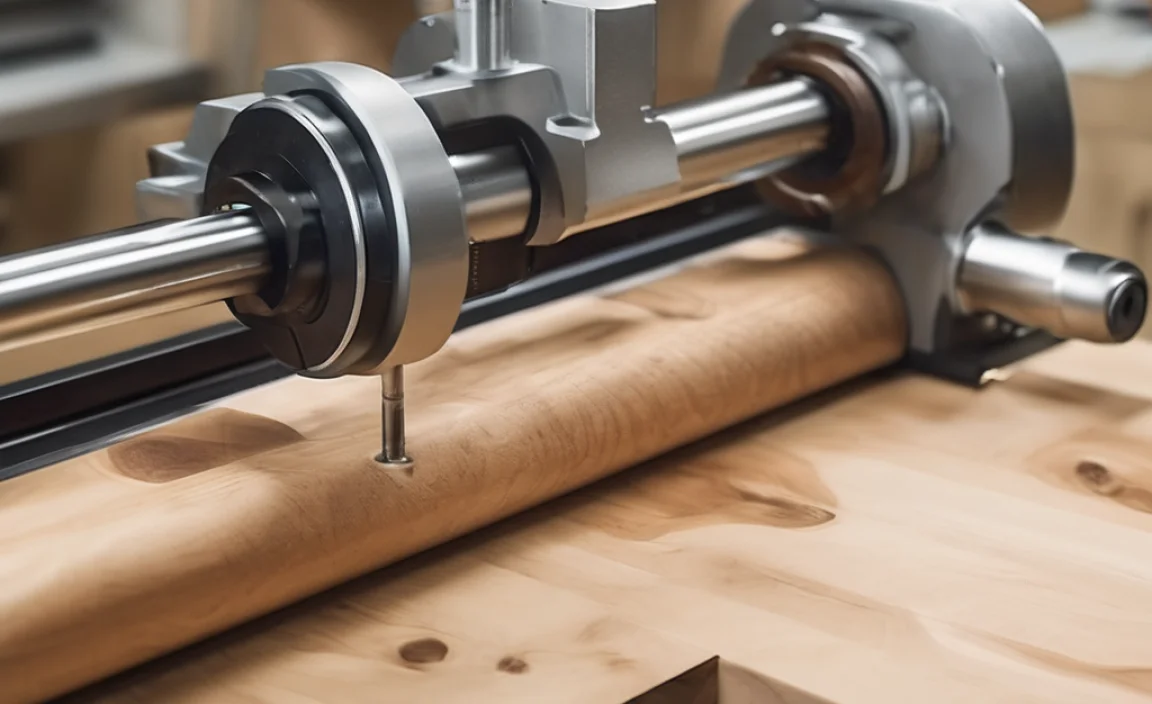For Stainless Steel 304, the best 3/16 inch single-flute, double-angle cutter is a precision tool designed for efficient material removal and a smooth finish. Choosing the right cutter ensures successful machining, preventing tool breakage and workpiece damage. This guide focuses on selecting and using this specialized cutter for optimal results.
Working with metal, especially something as resilient as Stainless Steel 304, can sometimes feel like a puzzle. When you’re aiming for precision with a 3/16 inch cutter, you might notice that not all cutters perform the same. Finding the “best” one, particularly one that shines with Stainless Steel 304, is key to saving time, frustration, and your workpiece. Many beginners struggle to identify the right tool that can confidently tackle this tough material without chipping or breaking. But don’t worry! We’re going to walk through exactly what makes a great 3/16 inch cutter for this job and how to use it effectively. Get ready to discover your new favorite workshop essential.
Why a 3/16 Inch Double-Angle Cutter is Your Go-To for Stainless Steel 304
When you’re diving into machining applications, especially with tougher materials like Stainless Steel 304, the choice of cutting tool is paramount. For a 3/16 inch size, a single-flute, double-angle cutter often rises to the top. Why this specific type? It comes down to how it interacts with the material.
Stainless Steel 304 is known for its strength and its tendency to work-harden. This means it gets tougher as you cut it. A standard multi-flute cutter can sometimes rub against the material rather than cutting cleanly, leading to heat buildup and premature tool wear, or even catastrophic tool failure.
A single-flute cutter, on the other hand, has more space for chip evacuation. This is crucial because it allows the metal chips to clear away from the cutting edge efficiently. Less chip recutting means less heat and a cleaner cut.
Now, about the “double-angle” part. These cutters have angled cutting surfaces on both sides of the flute. This design provides a sharper cutting action and helps to manage the forces applied to the workpiece and the tool. For materials like Stainless Steel 304, this optimized cutting geometry ensures a more aggressive yet controlled cut, reducing the risk of chatter and improving surface finish.
Choosing a cutter specifically designed for stainless steel, often with a bright or TiN (Titanium Nitride) coated finish, further enhances its ability to handle the heat and abrasion associated with this material.
Understanding Cutter Specifications: What to Look For
When you’re out shopping for the “best 3/16 inch cutter” for Stainless Steel 304, a few key details will make all the difference. It’s not just about grabbing any old tool; it’s about picking one engineered for the task.
Material of the Cutter
The base material of your cutter is the first line of defense against wear and heat.
High-Speed Steel (HSS): A common and reliable choice. It’s tough and can withstand moderate cutting speeds. For Stainless Steel 304, HSS is a solid workhorse.
Carbide: Significantly harder and more heat-resistant than HSS. Carbide cutters can take higher speeds and feeds, leading to much faster machining times, especially in tough materials. If your budget allows and your machine can handle the rigidity, carbide is often superior for stainless steel.
Coating
A coating is like armor for your cutter, offering additional protection and performance benefits.
Uncoated: Basic, but can still perform well in less demanding applications or with softer materials.
TiN (Titanium Nitride): A very common and effective coating. It adds hardness, reduces friction, and improves heat resistance, making it excellent for stainless steel. You’ll often see a goldish hue on TiN-coated tools.
TiCN (Titanium Carbonitride): Harder than TiN and offers better wear resistance. It’s a great choice for even tougher machining jobs.
TiAlN (Titanium Aluminum Nitride): Excellent for high-temperature applications, which are common when machining stainless steels. It forms a passivation layer that further protects the tool.
Flute Design
We’ve touched on this, but it’s worth reiterating.
Single Flute: As discussed, ideal for stainless steel due to better chip clearance. This prevents chip recutting and reduces heat buildup.
Double Angle: The angled cutting surfaces provide a more efficient and cleaner cut.
Shank Diameter
Make sure the shank diameter matches your milling machine or lathe collet or chuck. The standard for a 3/16 inch cutter is usually a 3/16 inch shank, but always double-check.
Manufacturer Reputation
While you can find generic options, sticking with reputable tool manufacturers often provides more consistent quality and performance. Brands known for their cutting tools usually stand behind their products.
Key Features of an Essential 3/16 Inch Double-Angle Cutter for SS 304
When we talk about the “best 3/16 inch cutter” for Stainless Steel 304, we’re looking for specific characteristics that make it excel. This isn’t just any cutter; it’s a precision instrument tailored for a challenging material.
Optimized Geometry for Stainless Steel: Look for cutters marketed specifically for stainless steel. These will have a rake angle and clearance that help prevent work hardening and allow for a smoother cut.
Sharp Cutting Edges: For Stainless Steel 304, a razor-sharp edge is non-negotiable. It needs to slice through the material cleanly rather than pushing or dragging, which can cause work hardening.
Ejection Flute Design: Even in a single-flute design, the way the chips are guided out is critical. A well-designed flute helps prevent chips from packing in, which is a major cause of tool breakage and poor surface finish in stainless steel.
Heat Dissipation: Stainless steel generates a lot of heat during machining. The cutter material (like carbide), its coating, and even the flute design contribute to how well heat is managed and dissipated away from the cutting edge.
Rigid Construction: A sturdy cutter that won’t flex is essential. Flexing can lead to chatter, poor accuracy, and increased tool wear.
How to Use Your 3/16 Inch Double-Angle Cutter on Stainless Steel 304: A Step-by-Step Guide
Now that we know what to look for, let’s get down to using this specialized cutter. Safety and precision are key when working with any machining tool, especially with a material like Stainless Steel 304.
Step 1: Machine Setup and Safety First
Before you even think about turning on the machine, safety is paramount.
Personal Protective Equipment (PPE): Always wear safety glasses or a face shield, hearing protection, and sturdy work gloves. Long sleeves are a good idea to protect your arms.
Secure the Workpiece: Ensure your Stainless Steel 304 workpiece is firmly clamped in your milling machine vise or held securely on your lathe. Any movement can lead to dangerous conditions and a ruined part.
Cleanliness: Make sure your machine, work area, and the cutter itself are clean and free of debris.
Step 2: Secure the Cutter
Tool Holder/Collet: Insert the 3/16 inch shank of your cutter into the appropriate collet or tool holder. Ensure it’s seated fully and tightened securely. A loose tool is a recipe for disaster.
Runout Check: If you have an indicator, check for runout. Minimal runout ensures accuracy and prolongs tool life.
Step 3: Set Your Cutting Parameters
This is where experience and research pay off. For Stainless Steel 304 and a 3/16 inch cutter, you’ll generally need slower speeds and more robust feeds than you would for softer metals like aluminum.
Spindle Speed (RPM): For Stainless Steel 304 with a carbide 3/16 inch cutter, you might start around 300-600 RPM. If using HSS, you’ll need to go slower, perhaps 150-300 RPM. These are starting points; adjustments will be necessary.
Feed Rate: This is how fast you push the material into the cutter. You want to feed fast enough to create a chip, not rub. A good starting point might be 0.001 to 0.003 inches per revolution (IPR), or roughly 6 to 18 inches per minute (IPM) on a typical CNC mill.
Depth of Cut (DOC): For Stainless Steel 304, it’s best to take lighter depths of cut. A radial depth of cut (how much the cutter engages the side of the material) around 0.030″ to 0.060″ and an axial depth of cut (how deep it cuts along its length) around 0.060″ to 0.125″ is often a good starting point, depending on the operation.
You can find more detailed recommendations for machining Stainless Steel 304 from resources like Sandvik Coromant, a leader in metal cutting solutions.
Step 4: Apply Lubricant/Coolant
Machining stainless steel generates significant heat. Using a suitable cutting fluid or coolant is essential.
Purpose: Coolant lubricates the cutting zone, reduces friction, flushes away chips, and prevents the workpiece and tool from overheating.
Types: Flood coolant, mist coolant, or even a high-pressure coolant system can be used. For smaller operations, a good cutting paste or oil applied directly can suffice. Look for fluids recommended for stainless steel.
Step 5: Make the Cut
Engage Cutter: Slowly bring the cutter into the material at the set feed rate. Listen to the machine. A smooth cutting sound is what you’re aiming for. If it sounds like it’s screaming or chattering, stop and adjust your parameters.
Chip Evacuation: Keep an eye on the chips being produced. They should be relatively small and free-flowing. If they are long, stringy, or packing up, reduce your feed rate or depth of cut, or check your coolant application.
Multiple Passes: For deeper cuts, it’s almost always better to take multiple lighter passes rather than one heavy one. This preserves tool life and improves surface finish.
Step 6: Inspect and Refine
Post-Cut Inspection: Once the operation is complete, carefully inspect your workpiece for the desired dimensions and surface finish.
Tool Wear: Check the cutter for signs of excessive wear, chipping, or dulling. If you see signs of wear, you may need to adjust your parameters or consider a different tool.
Common Machining Operations Using a 3/16 Inch Double-Angle Cutter
This versatile little cutter isn’t just for one job. Its size and design make it useful for several common machining tasks, especially when working with Stainless Steel 304 on a milling machine.
1. Slotting
Creating slots is a very common application. The single flute allows it to plunge into the material and then move sideways to create a slot of the desired width and depth. Because it’s a 3/16 inch cutter, it’s perfect for creating slots of that exact width or for operations where you might mill out a larger pocket and then finish the edges with this cutter.
2. Pocketing
Similar to slotting, you can use this cutter to mill out recessed areas or pockets in your workpiece. For Stainless Steel 304, taking light passes and ensuring good chip evacuation is crucial for pocketing to avoid heat buildup and tool breakage.
3. Profiling (Contour Milling)
You can use this cutter to mill the external or internal profile of a part. Holding tight tolerances requires a rigid setup and finely tuned cutting parameters.
4. Engraving and Detail Work
While not its primary purpose, the small diameter makes it suitable for creating fine details or even simple engraving on the surface of your Stainless Steel 304 part. Again, slower speeds and careful control are key here.
5. Edge Break/Chamfering
For smaller chamfers or just breaking a sharp edge on a 3/16 inch dimension or radius, this cutter can be employed. It’s often more about breaking a sharp edge than creating a formal chamfer.
Pros and Cons: 3/16 Inch Double-Angle Cutter for SS 304
Like any tool, there are specific advantages and disadvantages to using a 3/16 inch double-angle cutter with Stainless Steel 304. Understanding these will help you make the best decisions in your workshop.
Pros:
- Excellent for Stainless Steel: Specifically designed geometry aids in cutting tough, gummy materials like SS 304.
- Good Chip Evacuation: The single flute provides ample space for chips to escape, reducing recutting and heat.
- Precise Cutting: The double-angle design offers a clean, efficient cut, crucial for accuracy.
- Versatile for Small Features: Ideal for creating narrow slots, small pockets, and fine details where larger cutters won’t fit.
- Reduces Work Hardening: When used correctly, it minimizes the tendency of stainless steel to harden during machining.
- Cost-Effective for Specific Jobs: Often more economical for small-diameter, specialized cutting tasks compared to larger, more complex tooling.
Cons:
- Limited Material Removal Rate: Due to its small size and the inherent toughness of SS 304, it’s not suited for heavy-duty material hogging.
- Machining Time: It can take longer to complete larger pockets or surfaces compared to multi-flute cutters.
- Tool Breakage Risk: If parameters are set incorrectly, or if chip evacuation fails, the small diameter is prone to breakage.
- Requires Precision Setup: Needs a rigid machine, secure workpiece, and accurate settings to perform optimally.
- Heat Management is Critical: Without proper coolant and appropriate speeds/feeds, it can quickly overheat and fail.
Alternative Cutters and When to Use Them
While the 3/16 inch double-angle single-flute cutter is a hero for its specific applications with Stainless Steel 304, it’s not the only tool in the box. Knowing about alternatives can help you choose the absolute best tool for different scenarios.
1. Ball End Mill
A 3/16 inch ball end mill has a hemispherical tip.
Best For: Creating rounded internal corners (e.g., in pockets), 3D contouring, and surfacing operations where a fillet is desired. It’s excellent for achieving smooth, organic shapes.
Vs. Double-Angle: A ball end mill can’t create sharp internal corners like a square end mill. It’s less efficient for pure slotting that requires flat-bottomed sides.
2. Square End Mill (Flat End Mill)
A 3/16 inch square end mill has a flat tip with sharp, 90-degree corners.
Best For: Creating square bottom slots and pockets, squaring up internal corners, perimeter profiling, and general milling tasks.
Vs. Double-Angle: Standard square end mills often have multiple flutes (2 or 4) which can be problematic for stainless steel if chip evacuation isn’t managed very carefully due to their tendency to rub. Single-flute square end mills for stainless steel do exist and are a good alternative to double-angle cutters for creating square features.
3. Corner Radius End Mill
This is essentially a square end mill with a small radius on its corners.
Best For: Creating slots and pockets with slightly rounded internal corners, which adds strength and reduces stress risers compared to a sharp internal corner. Profiling parts where a smooth transition at the corners is needed.
Vs. Double-Angle: Offers more rigidity than a double-angle cutter for given parameters, and the radius helps prevent chipping in stainless steel.
4. Form Tools (e.g., Ball Nose, T-Slot)
These are specialized tools for creating specific shapes.
Best For: A ball nose is a type of ball end mill. A T-slot cutter is designed specifically to create T-slots in a single operation.
Vs. Double-Angle: These are highly specific for their intended shapes and are not general-purpose cutters like the double-angle.
When selecting an alternative, always consider the material (Stainless Steel 304’s demands), the operation, and the desired finish. For many intricate tasks on SS 304 where a clean cut and good chip flow are paramount, the single-flute double-angle cutter remains a top choice.
Troubleshooting Common Issues
Even with the right tool, machining Stainless Steel 304 can present challenges. Here are some common problems and how to address them with your 3/16 inch cutter.
Issue: Chatter or Vibration
Cause: Loose machine components, incorrect speeds/feeds, too deep a cut, dull tool, inadequate workpiece clamping.
Solution:
Ensure your workpiece is clamped very securely and that there’s no flex.
Check that your tool is rigidly held in the collet and that the collet is seated properly.
Experiment with slightly higher feed rates and shallower depths of cut.
Try adjusting your spindle speed by small increments.
Ensure you are using sharp tooling and adequate coolant.
Issue: Poor Surface Finish (Rough or Galled)
Cause: Tool rubbing instead of cutting, chip recutting, insufficient coolant, worn tool, incorrect angles.







